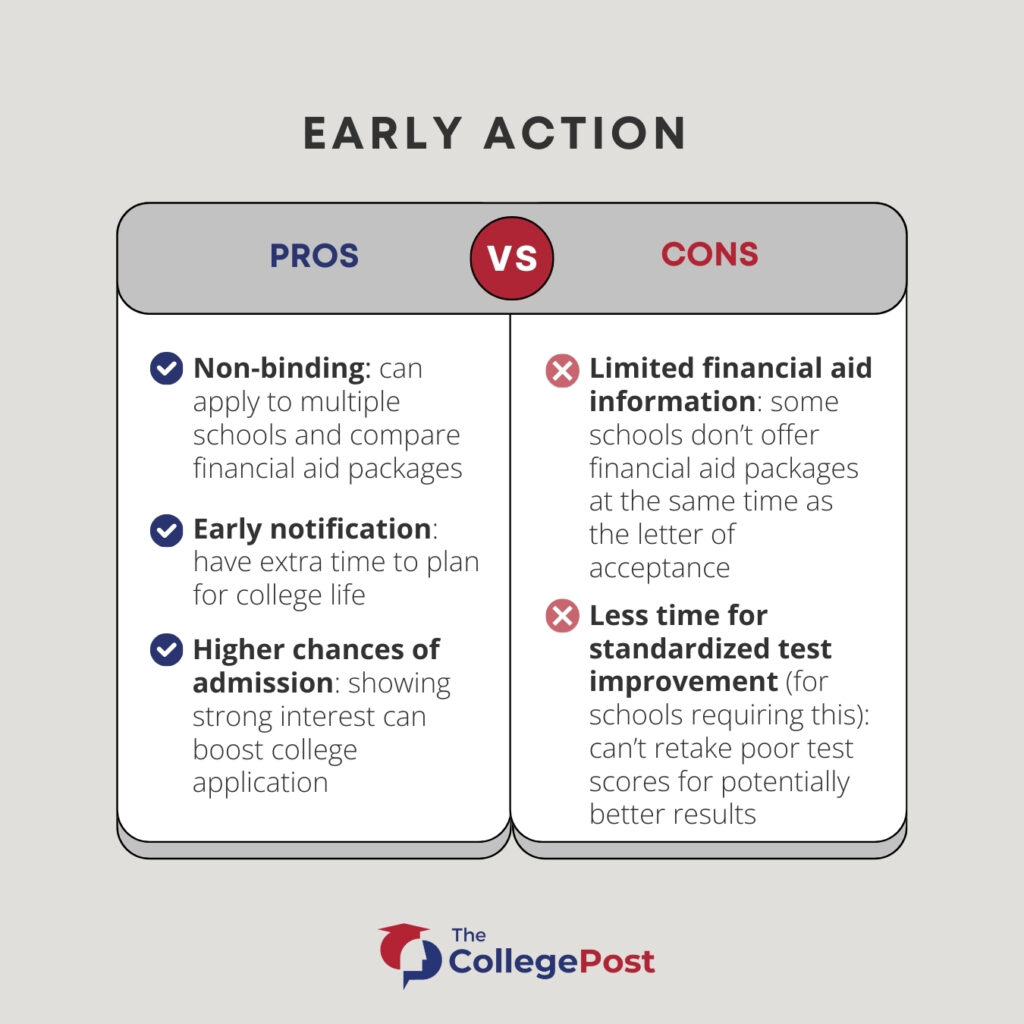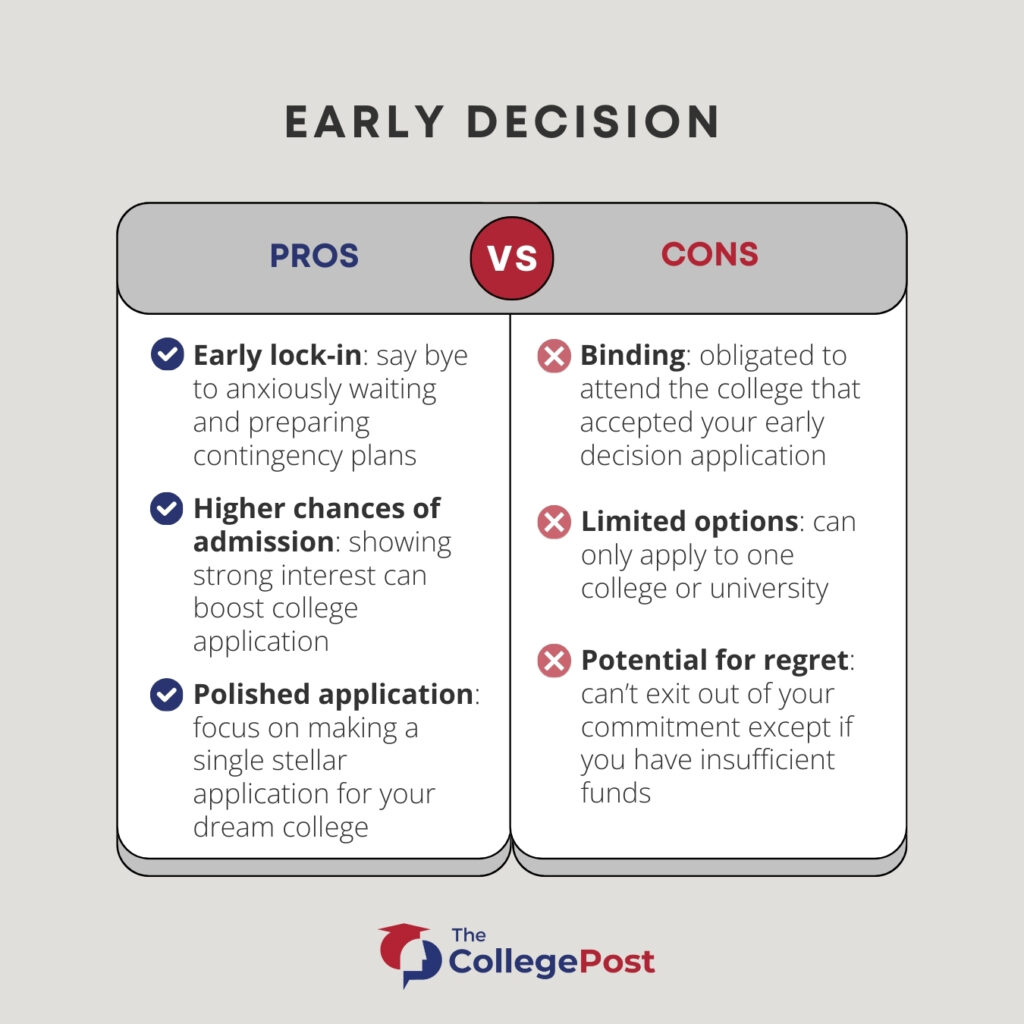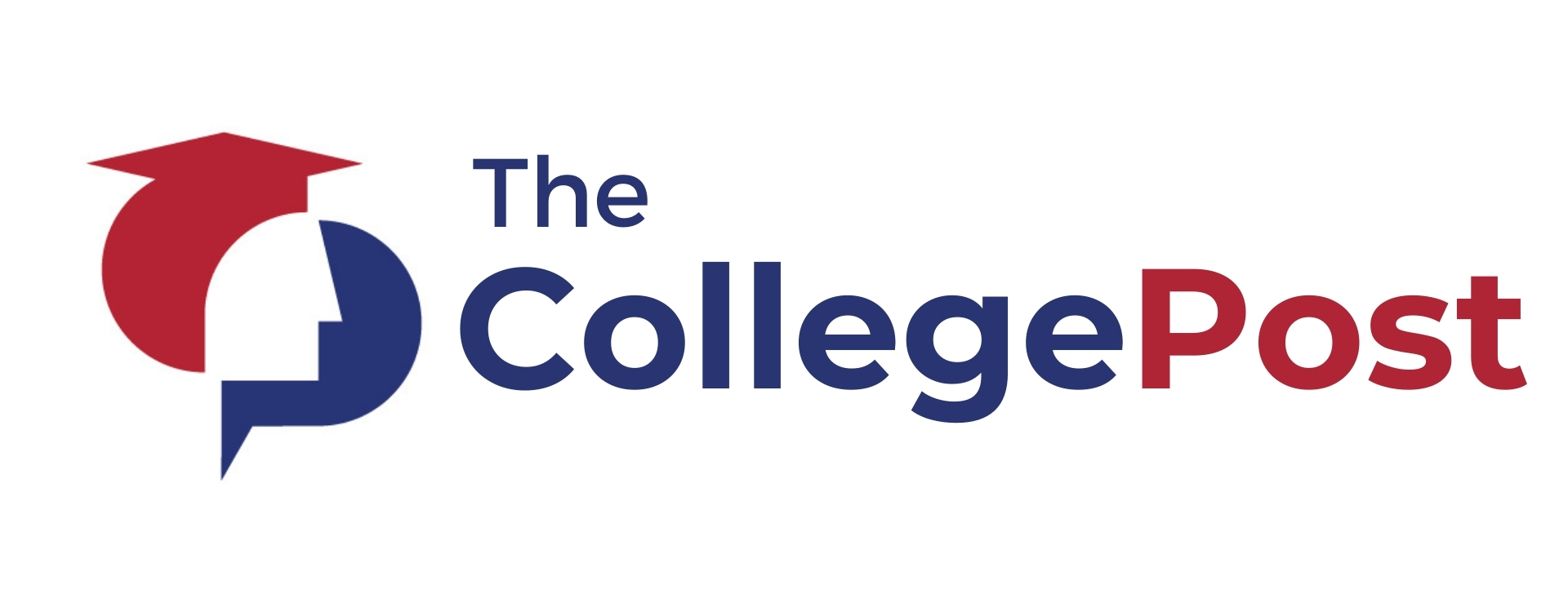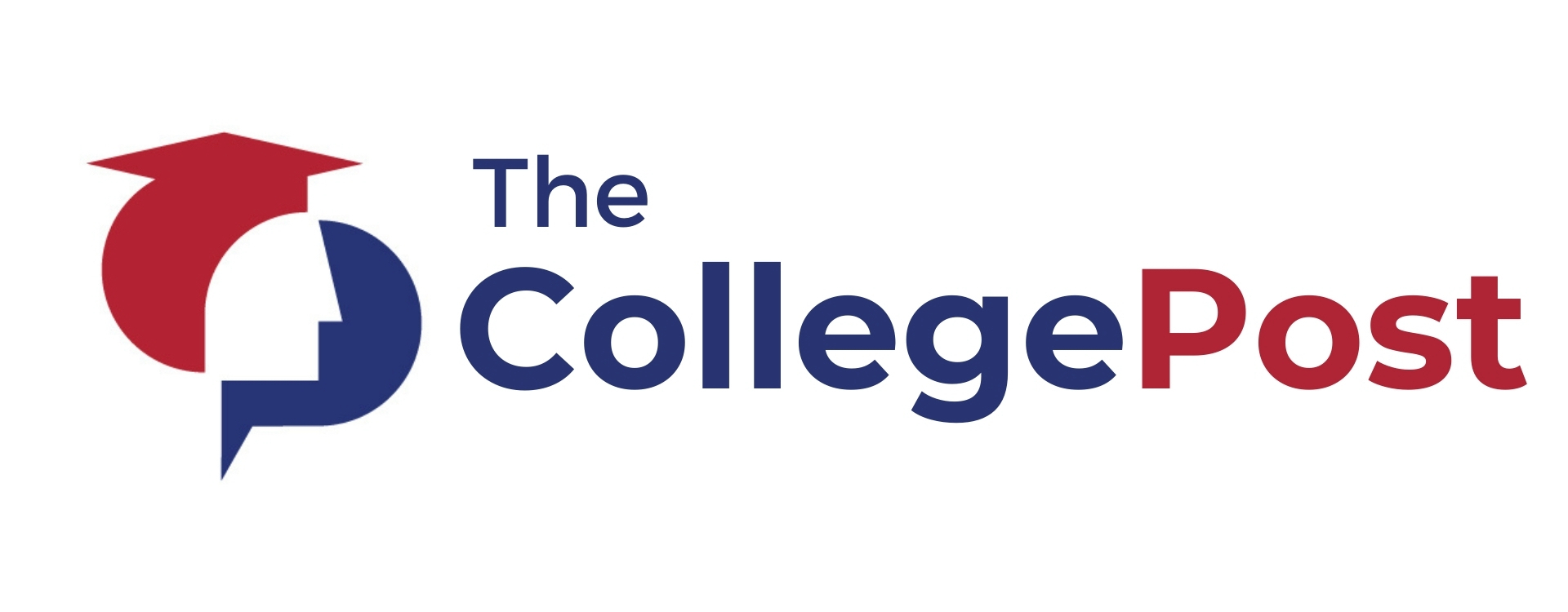Want to study at the college of your dreams? An early action or early decision application plan can increase your chances of getting your foot in the door. 🚪
Submitting your college applications earlier can mean that you’ve already received a letter of acceptance when your classmates are still working on their requirements to meet the regular application deadline. But before jumping on the bandwagon, here’s the 101 on early action vs early decision to see which pathway is a better match. ✅
- What is Early Action (EA)? 🤔
- What is Early Decision (ED)? 🤔
- What Are the Differences Between Early Action and Early Decision? ⚖️
- Advantages of Applying to College Early ✔️
- Downsides of Early Action and Early Decision 👎
- Early Action vs Early Decision: Which Should You Choose?
- Frequently Asked Questions: Early Action vs Early Decision: What’s the Difference?
What is Early Action (EA)? 🤔

Early action allows you to apply to one or more colleges earlier than regular applicants without the commitment (known as a non-binding agreement). Complete your college application documents, such as your high school transcript and letters of recommendation, on or before November 1st or November 15th, which is the usual deadline for early action applicants. 📅
You can receive your admission status as early as December. If accepted, you have three options: say yes to the offer right away, wait until May 1 (National College Decision Day), or choose not to attend the school because of the non-binding clause.
READ MORE: How to Apply for College in 9 Simple Steps
But watch out! ⚠️ When applying under early action, check whether your desired college has a restrictive or single-choice early action process. Under this agreement, you can only pursue early action at a single college instead of multiple schools, but it’s still non-binding. You’re likely to encounter this in the most competitive universities within the US.
Some colleges and universities offering non-restrictive early action are the Massachusetts Institute of Technology, the University of Chicago, and the Georgia Institute of Technology. On the other hand, Ivy Leagues like Harvard and Princeton offer single-choice early action to their applicants. 🏛️
Pros and Cons of Early Action

What is Early Decision (ED)? 🤔
Similar to early action, early decision allows you to apply to colleges before the regular application window. However, it is a binding agreement that means you can only pursue this option for one college, and you’re obligated to enroll if you get accepted. Do your research before considering this option because you’re required to sign an agreement stating your commitment to enroll at your chosen school and withdraw any other applications.
Colleges offering early decision will offer a financial aid package. If you don’t agree with the terms, that’s the only time you can back out from your commitment. ✍️

Early decision deadlines usually fall in November, and you’ll know whether you got in by December. Accepted students have to pay a non-refundable deposit, usually ranging between $100 to $400, before May 1st. If your application doesn’t make the cut, colleges can go two ways: rejection or deferral.
Unfortunately, rejected students cannot submit another application to that college in the same year, but deferred applicants can try their luck during the regular admissions period. In either case, you can continue with applications to other schools. Early decision can give colleges insight into potential enrollment numbers, and top schools like Brown University, Cornell University, and the University of Pennsylvania typically offer this. 👍
Note: The early decision applicant pool may be smaller because many high school students are still exploring, but prospective students should expect to compete with high-quality applications likely sent in by seniors who are sure of what they want.
Pros and Cons of Early Decision

What Are the Differences Between Early Action and Early Decision? ⚖️
Early action vs early decision — they might share similar names and timelines, but these application agreements offer contrasting conditions. Check out the key differences here:
| Early Action | Early Decision |
| You can apply early to multiple colleges. | You are bound to one institution. |
| You can compare financial aid offers from other schools. | You rely on one financial aid package, but you’re allowed to decline if it is insufficient. |
| You can take more time to figure out which school will work for you. | You send a stronger message of commitment to the institution. |
Advantages of Applying to College Early ✔️
Apart from checking “apply to college” off your to-do list, there are several other highly enticing benefits of choosing between early action vs early decision application pathways.

Higher Acceptance Rates 📈
You’re always rolling the dice when applying to colleges, so why not increase your odds? 🎲
Selected colleges offering early action and early decision tend to accept more applicants than those offered during the regular application period. For example, good-ranking schools like Tulane University have a 68 percent acceptance rate for its ED applicants, which is higher than its regular admission rate of 11 percent. 😲
Early applicants also have a better shot at institutions like the American University (86 percent for ED; 41 percent for regular applicants) and the University of Miami (57 percent for ED and EA; 19 percent for regular applicants). Other schools have also increased the number of ED students they admit per year by around five percent.
For 2022 to 2023, ED applicants have had more luck applying to schools like Vanderbilt University, Boston University, and Georgetown University. 🏫

Reduced Admission Stress 🧘
Getting an early start on your college applications can help you shake admissions stress. If your first-choice school offers you admission and an acceptable financial aid package, you can start preparing for the next stage in your education at an earlier time while everybody else is crossing their fingers and waiting for college results.
Plus, you won’t have to shell out more money on college application fees, have better housing options to choose from, and can begin to create a solid budgeting plan. 🥳

READ MORE: These Are the 60 Ranked US Colleges Without Application Fees [2023]
More Time to Get to Know the School 🤓
Along the same lines, applying early and getting accepted right away can give you more time to learn the ins and outs of your new school, like exploring available student clubs, planning your class schedule, or reaching out to online forums to learn about life on campus. Since you’ve been accepted earlier than other students, you’ll have first pick of student housing or nearby accommodations. The extra time can also be used to check out more financial aid options that might have opened up. 🏫

Second Chances ✨
If your early action or early decision strategy does not work out, you can take your chances during regular admissions or pursue other colleges. Rejection may be painful, but it comes with the territory, so don’t be too hard on yourself. Take some time to reflect on how to sharpen your application and what you’re looking for most in a college, then give it another go during regular admissions. 🤗

Downsides of Early Action and Early Decision 👎
Applying to college early has its pros, but knowing its disadvantages sets you up to make a balanced decision. Consider some of the common negatives of early action or early decision before rushing your application.

Increased Pressure 😫
Early decision and early action can speed up the college application process, but they also mean that deadlines are hot on your heels. You have to manage admission requirements and schoolwork sooner than your classmates, which means kissing goodbye to free time at the beginning of the school year!
Your grades must also be in tip-top shape before and during the deadline season because you won’t have the extra time to boost your profile with improved senior year grades and extracurricular activities. For early decision applicants, committing to only one school also invites pressure. Once the application is in, students are restricted from exploring other options.
It’s hard to live with the regret, so make sure your early decision college is the one that ticks all your boxes, like the quality and variety of programs, the type of community you want to be in, and proximity to your home. ✅

Limited Financial Aid Offers 💲
For students who rely on financial aid and want the best deal possible, applying early may not be the safest course of action. While early action offers more leniency, early decision ties you to one school where you’ll only get one financial aid proposal. Such restrictions prevent you from taking chances at other schools that may have better academic subsidies. 😞
TIP: Before pushing through with your early college applications, review the school’s website or call their financial aid office to get an idea of how much assistance is available.

READ MORE: How to Apply for Scholarships and Grants: All You Need to Know
False Sense of Security 😵
Many colleges accept a high number of early decision and early action applicants, but it doesn’t mean that admission is 100 percent guaranteed. Build a contingency plan and be prepared to submit additional college applications so you won’t have to scramble at the last minute if you get denied admission, especially since you can’t reapply during the regular admissions in the same cycle of a particular college. 👍

Early Action vs Early Decision: Which Should You Choose?
Most colleges only offer one or the other, and rarely both. Apply as an early decision applicant if you’re convinced that your dream college can fulfill your academic and extracurricular needs and that you can afford to attend your chosen school. 💯
This commitment is best for students who’ve done their research and are confident with a strong application. Meanwhile, if you’re prepared to apply early but want to keep your college options open, early action is the way to go. 😀

Now that you know the difference between early action vs early decision, it’s time to make headway on your college applications because the clock is ticking. Whichever direction you take, accelerating your college search allows you to say hello to the next chapter of your life sooner rather than later. 👋
Frequently Asked Questions: Early Action vs Early Decision: What’s the Difference?
Do all colleges offer early action and early decision?
Not all colleges offer both early action and early decision application options. College Board reports that only around 450 US colleges offer either early action or early decision, and even fewer offer both options.
This type of admission is also more common in private schools than in public ones. Some institutions do two rounds of each process, generally termed ED I, ED II, EA I, and EA II.
Are my chances of acceptance higher with early action or early decision?
More often than not, early decision applicants secure a college slot — about 61 percent of the time.
The favorable rate is due to colleges aiming to improve or maintain the yield rate (the percentage of accepted students that enroll), which is an important element in world rankings.
Your college application will still determine whether or not you are accepted. However, applying early can show interest and commitment that can attract the attention of admissions officers.
What are the deadlines for early action and early decision?
Early application deadlines may vary from school to school, but most institutions ask for applications on or before November 1 or November 15. They typically send results out in December.
This may be the general practice, but it’s best to check actual deadlines released by your prospective colleges.
Will applying early affect my financial aid package?
Applying to college early decision has a greater impact on your financial aid offers than early action.
ED applicants may miss the chance to compare financial aid packages from multiple schools since they are bound to a single college. But, if the school you applied to cannot give you the appropriate financial support, you are allowed to decline early admission.
Is early action better than early decision?
It depends. Early action is better when it comes to comparing financial aid packages, something students might find crucial given the increasing price of college fees each year.
But if you are firmly set on your dream college and believe you have the right credentials for it, going for the early decision application might be your best shot at getting in.
Ultimately, the advantage of either option (or none of them) depends on your college goals, financial capacity, and preferred higher education timeline.
Is there a downside to applying early action?
Yes. A few downsides to applying to college early action are reduced financial aid packages to use for comparison, being pressured to choose where to attend if you get accepted in more than one college, and the fact that most Ivy League universities offer this option with restrictions, such as single choice early action.
Is it harder to get in early action or regular decision?
In general, it is easier to get in with an early action application because of its relatively smaller application pool (compared to regular decision), and applying early tends to show interest and commitment to the school that can add points to your application.


